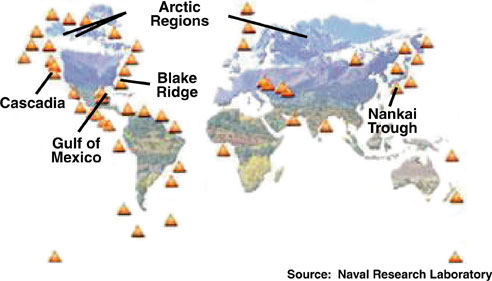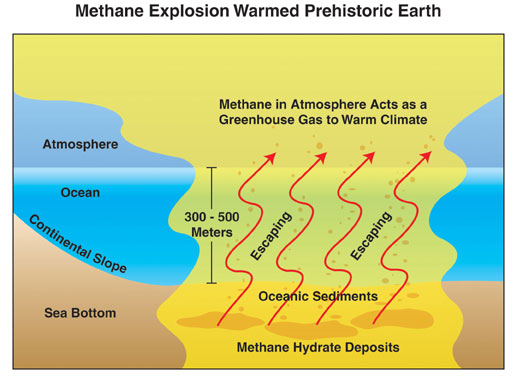December 10, 2001
A tremendous release of methane gas frozen beneath the sea floor heated the Earth by up to 13 degrees Fahrenheit (7 degrees Celsius) 55 million years ago, a new NASA study confirms. NASA scientists used data from a computer simulation of the paleo-climate to better understand the role of methane in climate change. While most greenhouse gas studies focus on carbon dioxide, methane is 20 times more potent as a heat-trapping gas in the atmosphere.

This graphic shows current known methane hydrate, or frozen methane gas, deposits worldwide. Methane hydrate occurs in ocean sediments along continental margins beneath the sea floor where water depths exceed 300 to 500 meters (about 1000 to 1600 feet) and cold temperatures and high pressure keep the methane stable. It also exists in permafrost. This unique substance forms when molecules of frozen water encase molecules of methane. The methane itself is created by decomposing organic matter in ocean sediments. Scientists are currently trying to figure out how to tap these huge stores of fossil fuel, without releasing methane into the atmosphere where it would exacerbate global warming.
Credit: Naval Research Laboratory
In the last 200 years, atmospheric methane has more than doubled due to decomposing organic materials in wetlands and swamps and human aided emissions from gas pipelines, coal mining, increases in irrigation and livestock flatulence.
However, there is another source of methane, formed from decomposing organic matter in ocean sediments, frozen in deposits under the seabed.
"We understand that other greenhouse gases apart from carbon dioxide are important for climate change today," said Gavin Schmidt, the lead author of the study and a researcher at NASA's Goddard Institute for Space Studies in New York, NY and Columbia University's Center for Climate Systems Research. "This work should help quantify how important they have been in the past, and help estimate their effects in the future."
The study will be presented on December 12, 2001, at the American Geophysical Union (AGU) Fall Meeting in San Francisco, Calif.
While most greenhouse gas studies focus on carbon dioxide, methane is 20 times more potent as a heat-trapping gas in the atmosphere. This pie chart shows natural and anthropogenic sources and relative quantities of methane currently released into the atmosphere.
Natural sources include wetlands, termites, decomposing organic materials in ocean and fresh water, and methane hydrate. Anthropogenic influenced sources include livestock flatulence, rice paddies, biomass burning, landfills, coal mining, and gas production, with rice paddies and livestock flatulence being the major sources of methane.
In the last 200 years, atmospheric methane has more than doubled largely due to human influences. Some scientists speculate current global heating could eventually warm the oceans enough to thaw frozen methane beneath the sea floor, leading to an increase of methane in the atmosphere. The findings of this research show that when large amounts of methane were released 55 million years ago, the planet warmed by up to 13 degrees Fahrenheit (7 degrees Celsius).
Credit: U.S. Department of Energy Technology Laboratory, National Methane Hydrate Program
Generally, cold temperatures and high pressure keep methane stable beneath the ocean floor, however, that might not always have been the case. A period of global warming, called the Late Paleocene Thermal Maximum (LPTM), occurred around 55 million years ago and lasted about 100,000 years. Current theory has linked this to a vast release of frozen methane from beneath the sea floor, which led to the earth warming as a result of increased greenhouse gases in the atmosphere.
A movement of continental plates, like the Indian subcontinent, may have initiated a release that led to the LPTM, Schmidt said. We know today that when the Indian subcontinent moved into the Eurasian continent, the Himalayas began forming. This uplift of tectonic plates would have decreased pressure in the sea floor, and may have caused the large methane release. Once the atmosphere and oceans began to warm, Schmidt added, it is possible that more methane thawed and bubbled out. Some scientists speculate current global heating could eventually lead to a similar scenario in the future if the oceans warm substantially.
When methane (CH4) enters the atmosphere, it reacts with molecules of oxygen (O) and hydrogen (H), called OH radicals. The OH radicals combine with methane and break it up, creating carbon dioxide (CO2) and water vapor (H2O), both of which are greenhouse gases. Scientists previously assumed that all of the released methane would be converted to CO2 and water after about a decade. If that happened, the rise in CO2 would have been the biggest player in warming the planet. But when scientists tried to find evidence of increased CO2 levels to explain the rapid warming during the LPTM, none could be found.
The models used in the new study show that when you greatly increase methane amounts, the OH quickly gets used up, and the extra methane lingers for hundreds of years, producing enough global warming to explain the LTPM climate.
"Ten years of methane is a blip, but hundreds of years of atmospheric methane is enough to warm up the atmosphere, melt the ice in the oceans, and change the whole climate system," Schmidt said. "So we may have solved a conundrum."
Schmidt said the study should help in understanding the role methane plays in current greenhouse warming.
"If you want to think about reducing future climate change, you also have to be aware of greenhouse gases other than carbon dioxide, like methane and chlorofluorocarbons," said Schmidt. "It gives a more rounded view, and in the short-term, it may end up being more cost-efficient to reduce methane in the atmosphere than it is to reduce carbon dioxide."

This graphic depicts the transfer of frozen methane deposits beneath the sea floor to the atmosphere. Generally, cold temperatures and high pressure keep the methane stable beneath the sea floor. But during the Late Paleocene Thermal Maximum (LPTM), around 55 million years ago, scientists believe movement of tectonic plates reduced the pressure in the sea floor and released the methane. When that happened, the methane bubbled out into the atmosphere, where it acted as a greenhouse gas, and heated the planet by up to 13 degrees Fahrenheit (7 degrees Celsius). It is also possible that once the atmosphere and oceans began to warm, more methane thawed and bubbled out.
Credit: Debbi McLean,
For more information please see:
http://www.gsfc.nasa.gov/topstory/20011212methane.html
Editor's Note: AGU Time and Location
Wednesday, December 12, 2001, 1:30 PM, Moscone Center Hall D
###
Contact:
Timothy R. Tawney
Goddard Space Flight Center, Greenbelt, Md.
Phone: 301/614-6573 or AGU Press Room 415/905-1007
ttawney@pop100.gsfc.nasa.gov
Krishna Ramanujan
Goddard Space Flight Center, Greenbelt, Md.
Phone: 301/286-3026 or AGU Press Room 415/905-1007
Kramanuj@pop900.gsfc.nasa.gov

